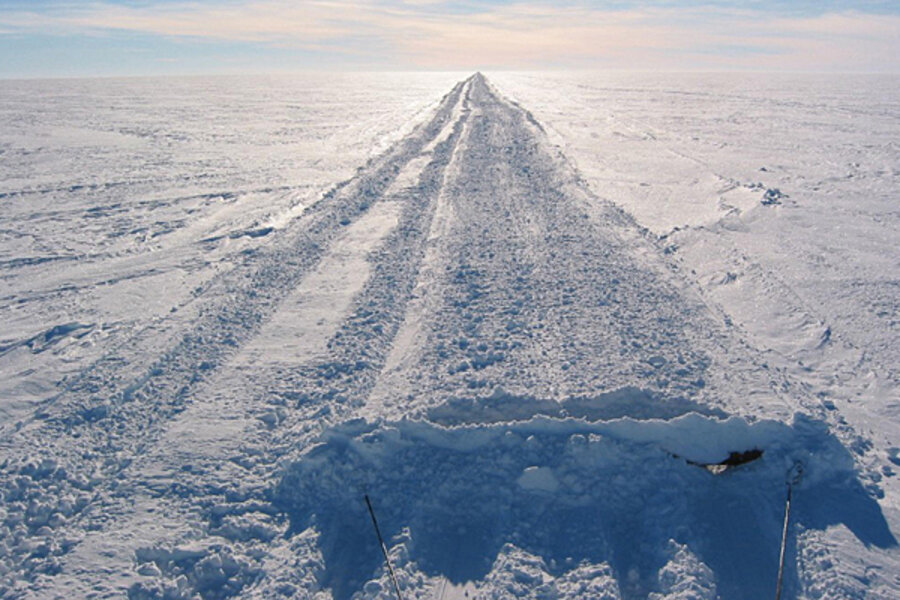South Pole revisited in 'Race to the End of the Earth'
At the beginning of the 20th Century, two groups of explorers set out across the desolate Antarctic landscape in a race to walk where no man had walked before.
The race culminated an era called "the Golden Age of Discovery," with the teams braving starvation, isolation and the world's coldest temperatures for the progress of science, the honor of their country and the immense personal glory that would come from reaching the South Pole first.
"Race to the End of the Earth," the new exhibit at the American Museum of Natural History (AMNH) in New York, recounts the momentous and deadly race between two explorers to be the first to reach the South Pole.
IN PICTURES: Disappearing glaciers
The legend of those explorers, Roald Amundsen and Robert Scott is brought to life in the exhibit. Amundsen's tale of success supplies heroic momentum to the show, while Scott's story of stoic perseverance in the face of certain death adds an underlying note of pathos.
Amundsen made it to the South Pole on Dec. 14, 1911, and reached the safety of Australia three months later. Scott found his way to the pole on Jan. 17, 1912, but he and his team died on the way back, stuck in a freezing blizzard without food or fuel.
Other than some oddly placed displays of wildlife, the exhibit does an excellent job of submerging the visitor in the excitement of the race, and surpasses the extremely popular 1999 exhibit about Ernest Shackleton's failed Antarctic expedition in design and interactivity. "Race" develops both Antarctica and the explorers who tried to conquer it into fully formed characters.
To start, visitors pass between monumental, stylized glaciers that bathe the entrance way in a cool blue light. The effect is literally chilling — one reason why this exhibit is perfect for hot summer days.
A display of artifacts from Scott and Amundsen's expeditions introduces the characters, and puts them in a historical context. Full-scale recreations of their base camps and examples of their cold weather gear viscerally transport visitors into the mindset of an Antarctic explorer.
These dioramas also clearly illustrate how Amundsen's planning prepared him for success, while Scott's equipment doomed him to a frozen grave. Amundsen's team wore fur suits based off the Eskimo outfits Amundsen saw in the Arctic. Scott wore wool cloths too light to protect them from the vicious Antarctic chill. Seeing them side by side allows the visitor to imagine themselves inside the suits, and pick which one they would rather brave the cold in.
The show ends with a rundown of modern Antarctic science. A composite igloo and a Gortex suit highlight how far the technology that today's Antarctic explorers use has come, while an interactive Flash display lets visitors explore the continent in great detail. A display of fossils from the South Pole not only explains the fruits of Antarctic research, but also shows off what the AMNH does best.
The exhibit's single misstep comes from oddly placed models of wildlife. A diorama of penguins proves a distracting tangent from the story of the different base camps. And in the area about modern science, a model seal hangs from the rafters, giving the impression that visitors are deep beneath the water, which doesn't seem consistent with the rest of the surface-focused exhibit.
"Race to the End of the Earth" is one of the marquee events of the summer in New York City. Interactive enough for children and interesting enough for adults, anyone with a taste for tales of adventure needs to spend at least one of the coming hot days cooling off in the company of these blizzard-braving explorers.
"Race to the End of the Earth" is on view at the American Museum of Natural History through Jan. 2, 2011.
- Gallery: Race to the South Pole in Images
- Extreme Living: Scientists at the End of the Earth
- South Pole Has Warmest Year on Record
IN PICTURES: Disappearing glaciers





